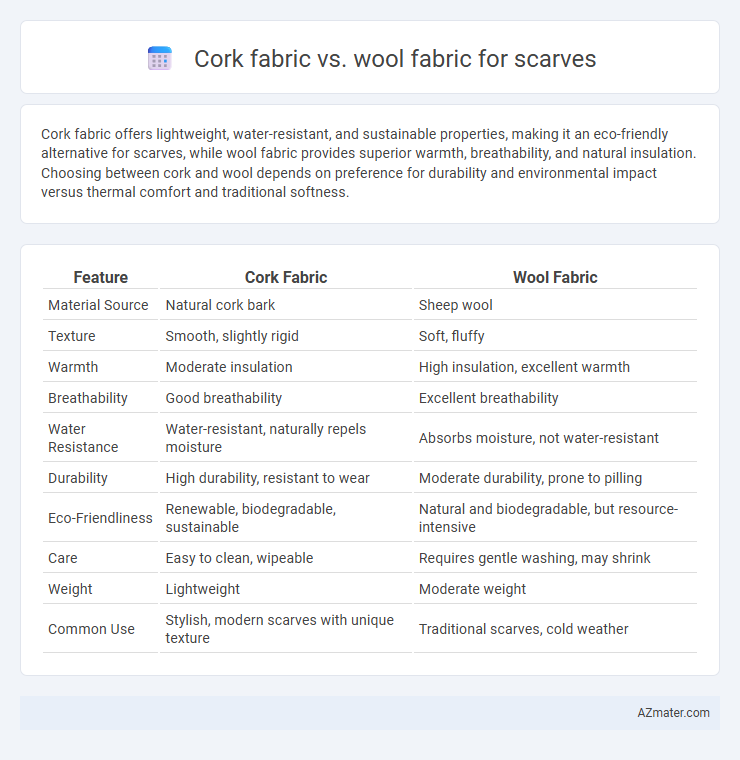Cork fabric offers lightweight, water-resistant, and sustainable properties, making it an eco-friendly alternative for scarves, while wool fabric provides superior warmth, breathability, and natural insulation. Choosing between cork and wool depends on preference for durability and environmental impact versus thermal comfort and traditional softness.
Table of Comparison
| Feature | Cork Fabric | Wool Fabric |
|---|---|---|
| Material Source | Natural cork bark | Sheep wool |
| Texture | Smooth, slightly rigid | Soft, fluffy |
| Warmth | Moderate insulation | High insulation, excellent warmth |
| Breathability | Good breathability | Excellent breathability |
| Water Resistance | Water-resistant, naturally repels moisture | Absorbs moisture, not water-resistant |
| Durability | High durability, resistant to wear | Moderate durability, prone to pilling |
| Eco-Friendliness | Renewable, biodegradable, sustainable | Natural and biodegradable, but resource-intensive |
| Care | Easy to clean, wipeable | Requires gentle washing, may shrink |
| Weight | Lightweight | Moderate weight |
| Common Use | Stylish, modern scarves with unique texture | Traditional scarves, cold weather |
Introduction to Cork Fabric and Wool Fabric
Cork fabric is derived from the bark of the cork oak tree, offering a sustainable, lightweight, and water-resistant alternative to traditional textiles. Wool fabric, sourced from sheep fleece, provides natural insulation, breathability, and moisture-wicking properties ideal for warmth and comfort. Both materials present unique benefits for scarf production, balancing eco-friendliness and thermal performance.
Origin and Production Processes
Cork fabric is derived from the bark of the cork oak tree (Quercus suber), primarily harvested in Mediterranean regions such as Portugal and Spain through a sustainable stripping process that allows the tree to regenerate its bark. Wool fabric originates from the fleece of sheep, predominantly sourced from countries like Australia and New Zealand, where shearing collects fibers subsequently cleaned, carded, and spun into yarn. The production of cork fabric involves natural pressing and treatment of cork sheets to achieve flexibility and durability, whereas wool undergoes processes like scouring, combing, and weaving to create soft, insulating textiles ideal for scarves.
Texture and Comfort Comparison
Cork fabric offers a smooth, lightweight texture with a natural, slightly spongy feel that provides excellent breathability and water resistance, making it ideal for allergy-sensitive skin. Wool fabric features a soft, insulating texture with natural elasticity and warmth, providing superior comfort in colder climates and effective moisture-wicking properties. When comparing Cork and Wool fabrics for scarves, Cork excels in lightweight comfort and hypoallergenic qualities, while Wool delivers enhanced warmth and softness for cold-weather wear.
Sustainability and Eco-Friendliness
Cork fabric, made from renewable cork oak bark, offers superior sustainability compared to wool by being biodegradable, water-resistant, and harvested without tree felling, making it an eco-friendly choice for scarves. Wool, while biodegradable and renewable, involves higher environmental costs due to land use, methane emissions, and water consumption related to sheep farming. Choosing cork fabric for scarves minimizes ecological impact through sustainable harvesting practices and reduced carbon footprint.
Insulation and Warmth Properties
Cork fabric offers excellent natural insulation and moisture-wicking properties, making it lightweight yet warm for scarf use. Wool fabric excels in thermal regulation due to its crimped fibers that trap heat effectively, providing superior warmth and breathability. Both materials are durable, but wool generally retains heat better in extremely cold conditions compared to cork fabric.
Durability and Longevity
Cork fabric offers exceptional durability due to its resistance to water, stains, and wear, making it a long-lasting option for scarves in varying weather conditions. Wool fabric boasts natural elasticity and resilience, providing excellent heat retention and durability with proper care, but it is prone to pilling and damage from moths. Between the two, cork fabric tends to have greater longevity in outdoor environments, while wool delivers warmth and durability best suited for cooler, dry climates.
Hypoallergenic and Skin Sensitivity Factors
Cork fabric is naturally hypoallergenic and resistant to dust mites and mold, making it ideal for individuals with sensitive skin or allergies, while wool fabric can sometimes cause irritation or itchiness due to lanolin content. Cork's smooth texture minimizes skin friction, reducing the risk of rashes and allergic reactions often associated with wool. Choosing cork fabric for scarves provides a breathable, non-toxic option that supports comfort for sensitive skin, unlike traditional wool materials.
Maintenance and Care Requirements
Cork fabric scarves require minimal maintenance due to their natural water resistance and durability, only needing occasional wiping with a damp cloth to remove dirt. Wool scarves demand more careful care, typically requiring hand washing or dry cleaning to prevent shrinking and fabric damage. Both materials benefit from air drying rather than heat sources to maintain their shape and longevity.
Style, Versatility, and Design Options
Cork fabric offers a unique, eco-friendly appeal with a smooth, leather-like texture that adds a modern, minimalist style to scarves, while wool fabric delivers classic warmth and natural insulation with rich texture suitable for traditional and contemporary designs. Wool scarves provide greater versatility in varying climates due to their insulating properties, whereas cork fabric scarves excel in lightweight, water-resistant wear, ideal for mild weather and urban fashion. Design options for wool include diverse patterns, colors, and knit styles that emphasize comfort and tradition, whereas cork fabric supports printed or embossed motifs that highlight sustainability and innovative aesthetics.
Cost-Effectiveness and Value for Money
Cork fabric offers exceptional cost-effectiveness for scarves due to its durability, lightweight nature, and resistance to water and stains, making it a budget-friendly choice with long-term value. Wool fabric, while often more expensive upfront, provides superior insulation and natural breathability, delivering excellent warmth and comfort that justifies its higher price for cold-weather use. Evaluating scarf materials based on intended climate and usage ensures that cork fabric suits casual, versatile wear whereas wool fabric remains the premium option for performance and luxury.

Infographic: Cork fabric vs Wool fabric for Scarf
 azmater.com
azmater.com